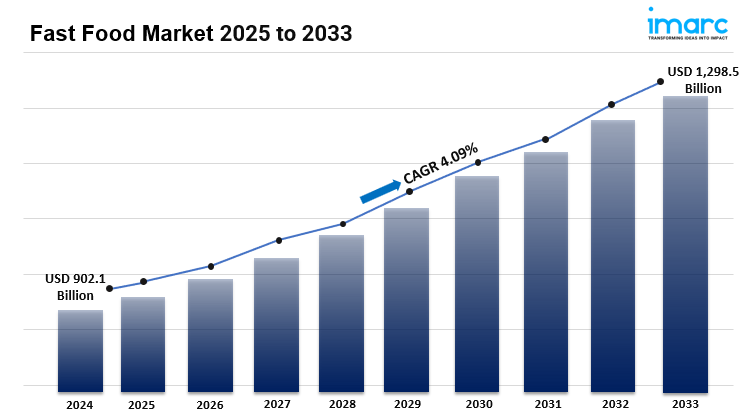MARKET OVERVIEW:
The global fast food market has experienced significant growth, reaching a value of USD 902.1 billion in 2024. Projections indicate that this momentum will continue, with expectations to reach USD 1,298.5 billion by 2033, reflecting a compound annual growth rate (CAGR) of 4.09% during 2025-2033. Ready-to-eat (rte) food products increasing strong predilection for consumers, the increase in the number of commercial establishments, and increased prevalence of fast food items such as frozen ready meals in food service have primarily driven this expansion.
Study Assumption Years:
- Base Year: 2024
- Historical Years: 2019-2024
- Forecast Years: 2025-2033
Fast Food Market Key Takeaways:
- Market Size and Growth: In 2024, the global fast food market was valued at USD 902.1 billion, with forecasts projecting it to reach USD 1,298.5 billion by 2033, at a CAGR of 4.09% from 2025 to 2033.
- Regional Performance: The United States fast food market reached USD 188.9 billion in 2024, expected to grow to USD 261.9 billion by 2033, exhibiting a CAGR of 3.4% during 2025-2033.
- Product Segmentation: Key product types include pizza/pasta, burgers/sandwiches, chicken, Asian/Latin American food, seafood, and others.
- End User Segmentation: The market serves various end users, including food-service restaurants, quick service restaurants, caterings, and others.
- Technological Advancements: The adoption of digital ordering systems, mobile applications, and efficient delivery services has enhanced consumer experiences and operational efficiencies.
- Health-Conscious Trends: There’s a growing demand for healthier fast food options, leading to menu diversification to include salads, wraps, and vegetarian meals.
Market Growth Factors:
Consumer convenience is one of the foremost reasons affecting the global fast food market. Increased urbanization and a fast-paced lifestyle are making people search for quick and easily accessible meal alternatives. The fast food establishments fulfill this requirement by providing consumers with ready-to-eat products that involve little time and effort.
The array of fast food is better priced and widely available; these factors only increase the appeal of fast food chains as potential meal venues for many consumers. This is particularly evident in metropolitan areas, where people working round the clock seldom have an hour to spare for a meal.
Technological advancement has placed a big boost behind the fast-food market. The implementation of digital order systems, mobile applications, and prompt delivery is transforming the consumer experience. These innovations afford customers uninterrupted and personalized communications, from tailoring orders to obtaining real-time tracking of deliveries. For example, online food delivery platforms have extended the reach of fast food outlets, allowing the restaurants to reach more people than just those living close by. With improved customer satisfaction and performance with operational processes, such digital transformation also increases profits.
The change in consumer tastes toward healthier and diversified options is another important growth factor. Fast-food firms expand their menus to cater to this increasing consumer need for healthy options: salads and wraps and plant-based items. Now, one can attract consumers who want something more balanced while still wanting simply convenience. In addition, offering cuisine from around the world, such as Asian and Latin American, captures the exploratory tastes of consumers, thus propelling the growth of the market. This diversification not just conforms to changing dietary preferences but also enhances the image of fast-food outlets as flexible dining establishments.
Request Sample For PDF Report: https://www.imarcgroup.com/fast-food-market/requestsample
Market Segmentation:
Breakup by Product Type:
- Pizza/Pasta
- Burger/Sandwich
- Chicken
- Asian/Latin American Food
- Seafood
- Others
Breakup by End User:
- Food-Service Restaurants
- Quick Service Restaurants
- Caterings
- Others
Market Breakup by Region:
- North America (United States, Canada)
- Asia Pacific (China, Japan, India, South Korea, Australia, Indonesia, Others)
- Europe (Germany, France, United Kingdom, Italy, Spain, Russia, Others)
- Latin America (Brazil, Mexico, Others)
- Middle East and Africa
Key Players:
- Auntie Anne’s (Focus Brands LLC)
- Chipotle Mexican Grill Inc.
- CKE Restaurants Holdings Inc.
- Domino’s
- Jack in the Box
- Little Caesar Enterprises Inc.
- McDonald’s
- Papa John’s International Inc.
- Restaurant Brands International Inc.
- Subway
- The Wendy’s Company
- Yum! Brands Inc.
Note: If you need specific information that is not currently within the scope of the report, we will provide it to you as a part of the customization.
About Us:
IMARC Group is a global management consulting firm that helps the world’s most ambitious changemakers to create a lasting impact. The company provide a comprehensive suite of market entry and expansion services. IMARC offerings include thorough market assessment, feasibility studies, company incorporation assistance, factory setup support, regulatory approvals and licensing navigation, branding, marketing and sales strategies, competitive landscape and benchmarking analyses, pricing and cost research, and procurement research.
